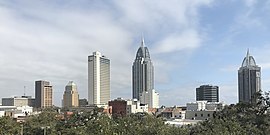East South Central states
East South Central | |
|---|---|
 States in dark red make up the East South Central states region | |
| Largest city | Nashville |
| Area | |
• Total | 183,403.90 sq mi (475,013.9 km2) |
| • Land | 178,289.84 sq mi (461,768.6 km2) |
| • Water | 5,114.07 sq mi (13,245.4 km2) |
| Population (2019)[2] | |
• Total | 19,176,181 |
| • Density | 100/sq mi (40/km2) |
The East South Central states is a region constituting one of the nine U.S. Census Bureau divisions. It is located within the American South. Four states make up the division: Kentucky, Tennessee, Mississippi and Alabama. The division is one of three that together make up the larger region known as the Southern United States (the other two are the more populous South Atlantic states and the West South Central states).
Historically, the area has been colonized and influenced by the French, Spanish, British, early American, and Confederate governments.[3][4][5][6] Distinct among these states, Alabama's French culture has been preserved through the Alabama Creoles,[7] and Kentucky's French culture can be observed throughout Louisville.[8] The East South Central states form the core of Old Dixie,[9] one of the nine moral regions identified by James Patterson and Peter Kim in their acclaimed 1991 geopolitical best-seller, The Day America Told The Truth.[10] Politically and culturally, the East South Central is more conservative than the other regions making up the American South; Mississippi, Alabama, Kentucky, and Tennessee's governments have been described during 2012 to 2023 as some of the most conservative.[11][12][13] Religiously, conservative Evangelical Protestantism dominates the East South Central as a central part of the Bible Belt.
Demographics
[edit]As of 2020, the East South Central states had a combined population of 19,430,030. The East South Central region covers 183,401 square miles of land. Within the region, Tennessee is the largest state by population, though Alabama is the largest by land area; Tennessee was also the East South Central's fastest growing state between 2010 and 2020,[14][15] with Alabama second.[16] Kentucky was the third-fastest growing state,[17] and Mississippi experienced population decline; despite population decline, Mississippi did increase in diversity.[18][19]
| State | 2020 estimate | Land area |
|---|---|---|
| Kentucky | 4,509,342 | 40,409 |
| Tennessee | 6,916,897 | 42,143 |
| Mississippi | 2,963,914 | 48,430 |
| Alabama | 5,039,877 | 52,419 |

| City | 2020 pop. | |
|---|---|---|
| 1 | Nashville, Tennessee | 689,447 |
| 2 | Memphis, Tennessee | 633,104 |
| 3 | Louisville, Kentucky | 633,045 |
| 4 | Lexington, Kentucky | 322,707 |
| 5 | Huntsville, Alabama | 215,006 |
| 6 | Birmingham, Alabama | 200,733 |
| 7 | Montgomery, Alabama | 200,663 |
| 8 | Knoxville, Tennessee | 190,740 |
| 9 | Mobile, Alabama | 187,041 |
| 10 | Chattanooga, Tennessee | 181,009 |
Politics
[edit]| Parties | ||||||||
| Nonpartisan | Democratic-Republican | Democratic | National Republican | Whig | Constitutional Union | Republican | Dixiecrat | American Independent |
- Bold denotes election winner.
References
[edit]- ^ "United States Summary: 2010, Population and Housing Unit Counts, 2010 Census of Population and Housing" (PDF). United States Census Bureau. September 2012. pp. V–2, 1 & 41 (Tables 1 & 18). Retrieved February 7, 2014.
- ^ "Population, Population Change, and Estimated Components of Population Change: April 1, 2010 to July 1, 2019 (NST-EST2019-alldata)". Census.gov. United States Census Bureau. Archived from the original on January 26, 2020. Retrieved February 8, 2020.
- ^ Pinnen, Christian; Weeks, Charles (2021). Colonial Mississippi: A Borrowed Land. University Press of Mississippi. ISBN 978-1-4968-3270-2.
- ^ "National Park Service - Explorers and Settlers (Alabama)". www.nps.gov. Retrieved January 25, 2023.
- ^ "Tennessee". HISTORY. Retrieved January 25, 2023.
- ^ "Kentucky Genealogical Society - Kentucky History". kygs.org. Retrieved January 25, 2023.
- ^ Blejwas, Emily (February 19, 2020). "Gumbo: Africans and Creoles on the Gulf Coast". Mobile Bay Magazine. Retrieved January 25, 2023.
- ^ "Timeline of Louisville, KY". Louisville Kentucky Government.
- ^ Dreher, Rod (September 10, 2021). "The Day They Drove Old Dixie Down". The American Conservative. Retrieved January 25, 2023.
- ^ "LITTLE GOOD NEWS IN `THE DAY AMERICA TOLD THE TRUTH`". Chicago Tribune. Retrieved January 25, 2023.
- ^ "Mississippi Most Conservative State, D.C. Most Liberal". Gallup.com. February 3, 2012. Retrieved January 25, 2023.
- ^ "Alabama Has the Most Conservative Legislature in the Nation". Governing. December 6, 2022. Retrieved January 25, 2023.
- ^ "CLA Report: Tennessee Ties For Second Most-Conservative State House". MemphisFlyer. Retrieved January 25, 2023.
- ^ "2020 Census Data: Tennessee Population Topping 6.9 Million". News. April 28, 2021. Retrieved January 25, 2023.
- ^ Yu, Yue Stella. "2020 Census results: Middle Tennessee drives population growth as state becomes more racially diverse". The Tennessean. Retrieved January 25, 2023.
- ^ "Alabama Population Grew 5.1% Since 2010, Surpassing 5 Million". Census.gov. Retrieved January 25, 2023.
- ^ "Kentucky Population Topped 4.5 Million in 2020". Census.gov. Retrieved January 25, 2023.
- ^ "Census shows Mississippi lost population and diversified". AP NEWS. April 26, 2021. Retrieved January 25, 2023.
- ^ Newsom, Michael (February 2, 2022). "UM Experts Warn About Consequences of Population Loss". Ole Miss News. Retrieved January 25, 2023.








